The relationship between magic systems and horror is hidden and unexplored territory, as secret as the black arts that lurk within the games themselves. Horror as used here refers not strictly to the genre of survival horror, which is a marketing construct invented in association with the first Resident Evil. Rather, horror-themed games include any game whose purpose is to evoke a sense of fear, dread, and the sublimity of unknown dark forces. Horror-themed games can be first person shooters, action-adventure games, and side-scrolling beat 'em ups. Magic is rarely the core mechanic of horror-themed games, often because players are put in the position of fighting magic through firearms and melee, or using magic only indirectly through artifacts. Magic and horror are intimately wedded in terms of themes but not in terms of direct player interaction.
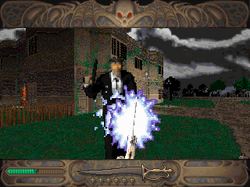 Yet, horror games often have the most original and memorable simulations of magic in terms of atmosphere and mood. What horror games have to teach us is their atmospheric simulation of magic, the Gothic mood that they associate with magic through a combination of art style, audio, and (sometimes) haptics. If more closely melded with the core mechanics of games, magic systems in horror games can be superb examples of design and provide inspiration for other hybrid genres.
Yet, horror games often have the most original and memorable simulations of magic in terms of atmosphere and mood. What horror games have to teach us is their atmospheric simulation of magic, the Gothic mood that they associate with magic through a combination of art style, audio, and (sometimes) haptics. If more closely melded with the core mechanics of games, magic systems in horror games can be superb examples of design and provide inspiration for other hybrid genres.
Magic appears prominently in horror games because of an endemic thematic preoccupation with the supernatural, with emphasis on its dark side as the infernal and the demonic. With this supernatural element in mind, the definition of magic systems can be further refined and extended from last week's blog entry. A magic system is a set of rules and symbols for rigorously simulating the alteration of reality through the will by the agency of a supernatural force, whether conceived of as a genuine metaphysical presence, a symbolic construct, or an energizing psychological reality. In keeping with Crowley's axiom from Magick and Theory and Practice that "any intentional act is a magical act," any act of gameplay requires the operation of the will to achieve a desired result in altering a symbolic reality; therefore, any game mechanic can potentially be looked at as magic. This definition could theoretically be extended to include snowboarding and guitar playing if the experience of these activities approached the transcendent (which according to some Rock Band devotees, it certainly does). However, those genres that most embrace the representation and simulation of the supernatural will tend to exhibit interrelated mechanics that can most rigorously be defined as magic systems.
Next to fantasy, horror is the narrative genre that most readily takes the supernatural as a fictional premise, rather than rationalizing or dismissing it. Hence, horror games will often but not always include some supernatural element but will also sometimes struggle to integrate it with the game's core mechanics, perhaps in part because magic in horror is frequently represented in Lovecraftian terms as eldritch and unknowable. The need to obscure the workings of the supernatural within a cloak of mystery can conflict with the goal of making mechanics rational and accessible to players. Approached clumsily, this fictional premise leads to the conclusion that the enemy has magic and the player does not, so she must shoot the enemy or hit him with a stick. Approached with subtlety, a horror-themed magic system can be as consummately rational as the black arts themselves, with their dread economy of souls bartered for power, and at the same time dense with mystery that emerges from unexpected combinations and effects.
From Doom to Demon's Souls, games abound in demonic manifestations and exorcisms, and while the first response of players and designers may be to fire a shotgun in the direction of the approaching devil, sooner or later it makes more sense to fight fire with fire. Hence, the protagonists of horror-themed first-person shooters and action-adventure games become scholars of the occult, wielding not just a gun but the arcane knowledge needed to defeat their enemies.
Magic haunts the fringes of Doom in the form of burning pentagrams and demonic enemies, highlighting an element of gameplay that may have deep archetypal resonance. Indeed, the highest function of gameplay in horror games may be to allow players to face their demons, both literally and figuratively: a trope as old as the first mythic attempts to grapple with the problem of evil. Despite the presence of demonic elements in Doom, the players' abilities remain primarily physical. As the prototypical first-person shooter (though not the first one, which was Wolfenstein 3D), Doom keeps its gameplay grounded in the obliteration of demons with ballistic firepower. Nonetheless, the player's use of teleporters etched with occult symbols (both pentagrams and sigils), allows him access to infernal realms, forcing him "knee deep in hell" in the game's own words. Doom is a game about accidentally opening a rift from Hell onto Mars, and the demons that spill out of this schism mirror the spillage of the supernatural into the otherwise physical activity of shooting.
The Heretic and Hexen series, a line of fantasy-themed Doom clones published by Ravensoft within Id's
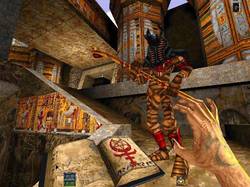 Doom engine, moved the mechanic of magic from periphery to the center of the first-person shooter, albeit in the form of re-skinned shooting mechanics. Because the series is heavily influenced by Doom, it also carries over some of Doom's dark aesthetic, resulting in magic that is both darkly themed and wielded against demonic enemies. Hexen is German for "witches" (and, more literally, "casting a spell"), and its gameplay delivers on the experience of spell-casting from a first-person perspective through the use of magical staffs and other items that fling spells when swung. First-person games with magic tend to represent spells as projectiles that release their magical effects on impact with either a character or an environmental object. Spells are often also accompanied by an animation file that represents either the swinging of a melee object or spell gestures such as hand-waving.
Doom engine, moved the mechanic of magic from periphery to the center of the first-person shooter, albeit in the form of re-skinned shooting mechanics. Because the series is heavily influenced by Doom, it also carries over some of Doom's dark aesthetic, resulting in magic that is both darkly themed and wielded against demonic enemies. Hexen is German for "witches" (and, more literally, "casting a spell"), and its gameplay delivers on the experience of spell-casting from a first-person perspective through the use of magical staffs and other items that fling spells when swung. First-person games with magic tend to represent spells as projectiles that release their magical effects on impact with either a character or an environmental object. Spells are often also accompanied by an animation file that represents either the swinging of a melee object or spell gestures such as hand-waving.
The appearance of magic within first-person shooters is an outgrowth of the action-RPG, a hybrid of real-time combat, first-person perspective, and role-playing elements like stat-based character advancement. Ultima Underworld helps solidify this sub-genre, but it comes most strongly into its own in the Elder Scrolls series, particularly the celebrated late installments Morrowind and Oblivion. Action-RPG's are exercises in immersion, eschewing turn-based combat and mouse-driven auto-targeting in favor of aiming melee attacks and spells in real time. Third-person perspective and turn-based combat have tended to dominate RPG's of the last five years, especially MMO's, in part because these games place emphasis on the display of avatars for performance-oriented identity and socialization. Yet, this distancing of player from avatar, in which players peer down over the shoulder of a character rather than seeing through her eyes and gesturing with her hands, puts a gap between spellcaster and spellcasting that can be detrimental to the immersive experience of magic.
In the first-person perspective, players can feel as if they are the ones casting the spells rather than watching someone else cast them. The Elder Scrolls, in addition to its diverse range of spell effects, lets players run, swing swords, and fling fireballs simultaneously. Because this process requires quick thinking and quicker reflexes, it increases the degree of immersion associated with magic, rather than permitting players to simply select a target and then click a row of icons. The Elder Scrolls universe is not predominantly horror-themed, though it does incorporate Lovecraftian elements (such as the mythos-named Daedra Mehrunes Dagon and the R'lyeh-influenced architecture of the Daedric shrines) within a somewhat Gothic world. However, first-person action-RPG's lay the groundwork for full integration of magic systems within a horror-themed FPS, which occurs in the cult classic Realms of the Haunting and Clive Barker's Undying.
Undying is a classic example of a player character whose gameplay abilities entail using the powers of the dark against itself. In Undying, the player takes the role of Patrick Galloway, a scholar of the occult who wields both spells and guns. In terms of gameplay, this story premise allows the player to shoot weapons with one hand and cast spells with the other. Many of the spells in Undying are traditional first-person shooter projectiles with magical particle effects attached, yet even these spells have a Gothic flair. In casting a Skullstorm spell, the player as Galloway pulls shrieking skulls out of graveyard soil and flings them at enemies, with the restriction that the spell can only be cast while standing on soil. Another spell summons and strengthens demons but can be used to cause a human enemy to turn his gun on himself. The Scry spell reveals hidden apparitions and messages. Because Undying's spells actually function as casting effects rather than being dependent on items like magical staffs, they feel less like disguised shooter mechanics and more like a hybrid genre, such as the awkwardly hyphenated horror-themed action-adventure-shooter.
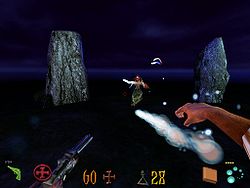 While Undying successfully adapts magic to the first-person action-shooter, two other third-person action-adventure examples feature a less graceful integration: Nightmare Creatures and Shadow Man, both of which games are distinctly within the vein of the Soul Reaver series. In Nightmare Creatures, the player can take the role of a priest and scholar of the occult fighting off a cult led by a mad scientist with the suspicious name of Adam Crowley. Magic in this game appears as a metaphor for combat (much as in the later Bayonetta), specifically in the form of staff techniques unleashed through button-based combos, as well as magical effects created by power-ups. In Shadow Man, magic takes the form of voodoo abilities powered through dark souls and artifacts called cadeaux, reinforcing a French and Caribbean-influenced take on the horror-themed action-adventure game. One review wryly refers to Shadow Man as "Resident Mario" in reference to the importance of collecting the gameplay equivalent of coins and stars in order to unlock new areas and powers. As with Hexen, magic in these games plays a heavy part in world, art, and narrative design but is kept at a distance from the game's core mechanics--with a greater distance between world and mechanics in Nightmare Creatures than in Shadow Man.
While Undying successfully adapts magic to the first-person action-shooter, two other third-person action-adventure examples feature a less graceful integration: Nightmare Creatures and Shadow Man, both of which games are distinctly within the vein of the Soul Reaver series. In Nightmare Creatures, the player can take the role of a priest and scholar of the occult fighting off a cult led by a mad scientist with the suspicious name of Adam Crowley. Magic in this game appears as a metaphor for combat (much as in the later Bayonetta), specifically in the form of staff techniques unleashed through button-based combos, as well as magical effects created by power-ups. In Shadow Man, magic takes the form of voodoo abilities powered through dark souls and artifacts called cadeaux, reinforcing a French and Caribbean-influenced take on the horror-themed action-adventure game. One review wryly refers to Shadow Man as "Resident Mario" in reference to the importance of collecting the gameplay equivalent of coins and stars in order to unlock new areas and powers. As with Hexen, magic in these games plays a heavy part in world, art, and narrative design but is kept at a distance from the game's core mechanics--with a greater distance between world and mechanics in Nightmare Creatures than in Shadow Man.
When the magic system of a horror game does manage to mesh the atmosphere of audio and visuals with an equally rich core mechanic, the results tend to be superb. In Eternal Darkness: Sanity's Requiem, magic (or magick, as the in-game text calls it) constitutes one of the core mechanics of this tremendous cult game, explored through a combinatorial language of runes whose multimodal richness and mythological depth far outstrip most magic systems. Eternal Darkness demonstrates that horror games can teach as much about the atmosphere of magic systems as their mechanics. The runic language of Eternal Darkness owes a debt to Dungeon Master and Ultima Underworld, but the audio of demonic chanting and visual explosions of symbolically-charged color of Eternal Darkness takes the game's magic system to an entirely new level.
Another superb example of magic in a game with horror elements is the masterful Vagrant Story, an RPG with strong survival horror elements, in which magic is the manifestation of a mysterious force called "the dark." Vagrant Story resonates with occult authenticity, since the player acquires spells from grimoires and doors are locked by sigils, both of which terms derive from ceremonial magic. Eschewing the Vancian system of Dungeons and Dragons, each grimoire is a spellbook with one spell which the player acquires permanently as his memories of abilities from a former life return. In a display of shockingly extensive research into kabbalistic and occult thought, several doors in the keep of Lea Monde are labeled with Hebrew letters glowing in symbolic colors.
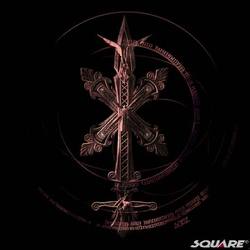 While Vagrant Story and Eternal Darkness may eschew the Vancian systems of Dungeons and Dragons, another classic horror writer casts his sublime shadow over both games and horror gaming in general: H.P. Lovecraft. The energizing influence of horror games on magic systems is analogous to the influence exerted by H.P. Lovecraft on Robert E. Howard, resulting in an infusion of Conan's low fantasy with a black dose of the Cthulhu mythos.
While Vagrant Story and Eternal Darkness may eschew the Vancian systems of Dungeons and Dragons, another classic horror writer casts his sublime shadow over both games and horror gaming in general: H.P. Lovecraft. The energizing influence of horror games on magic systems is analogous to the influence exerted by H.P. Lovecraft on Robert E. Howard, resulting in an infusion of Conan's low fantasy with a black dose of the Cthulhu mythos.
To contextualize this analogous influence, it is important to see that the predominant literary source of high fantasy in games is J.R.R. Tolkien's Lord of the Rings. J.R.R. Tolkien's Catholicism led him to downplay the use of magic by his protagonists, resulting in a predominately weak and diluted use of enchantments to harmoniously influence nature. (Gandalf's defiance of the Balrog is an exception, and Sauron's power is an exception that proves the rule by condemning magic as powerful but devastatingly wicked and destructive to self and other). The undeniable influence of Tolkien on fantasy RPG's has perhaps marred the seriousness and atmosphere of these games' magic systems, such that Gary Gygax classified magic in Tolkien's fiction as "generally weak and ineffectual." True to form, the magic system in Lord of the Rings Online can sometimes be a little less than thrilling, since the main casting class of Loremasters are a relatively lukewarm druid/mage hybrid with elemental magic powers and beast pets. (The addition of Runekeepers with electrical shock magic is slightly more intriguing but of dubious relationship to Tolkien's fiction).
In contrast, Robert E. Howard's vision of magic is sufficiently influenced by the Cthulhu mythos to become both darker and more rich than standard high fantasy, suggesting an analogous inspirational power for horror to influence magic systems in games. Lovecraft and Robert E. Howard corresponded extensively because of their mutual tendency to publish in Weird Tales. Magic in Howard's stories has a distinctly Lovecraftian eldritch quality, merged with a fascination with Egyptology to produce a vision of sorcery as evil and founded upon dangerous ties with demons. It is this vision of magic that works its way into the black decks of Magic: The Gathering, with their Demonic Tutors who convey knowledge at a price and the Overeager Apprentices whose presumption ends with splatters of their own blood on the walls.
 The magic system in Age of Conan literalizes the analogy between game genre and game fiction through a magic system that is dark and deep in both mechanics and atmosphere. As explained in an interview and confirmed on the Age of Conan site, magic in this MMO is:
The magic system in Age of Conan literalizes the analogy between game genre and game fiction through a magic system that is dark and deep in both mechanics and atmosphere. As explained in an interview and confirmed on the Age of Conan site, magic in this MMO is:
1) Dark
2) Dangerous
3) Difficult
As Gaute Godager, the director of the game, explains:
we try to make the visual look and feel of magic in Conan different from what you have seen in other games and the more traditional fantasy settings. The clownlike, fireball-tossing magic users in pointy hats, with puffs and multicolored robes, are not part of the Hyborian universe. In Conan's age, magic is dangerous, hidden, and dark. Men who meddle with magic inevitably fall to its temptation and powers. Magic uses you as much as you use it.
In terms of mechanics, magic in Age of Conan includes a high-level skill called spellweaving,
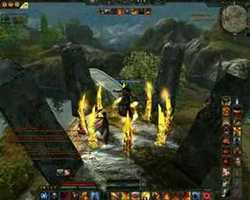 in which players can combine spells rhythmically in order to produce a meta-spell of devastating proportions. In an E3 demo of this feature, spellweaving was explained as representing the risky aspect of magic "where the magician summons a demon, does something wrong in the spell, and is pulled down into hell." This approach to magic is an attempt to represent within gameplay and audiovisual feedback the skill required to cast spells and the risk in misusing one's skills. Age of Conan drove many players away through a buggy launch and an initial lack of endgame content, but the vision behind this magic system and its larger place with a coherent and stirringly brutal world are unique. They entail a horror-influenced rejection of the cute and superficial approach to magic adopted by many mainstream RPG's and popular fantasy fiction, in favor of a vision of the arcane that is darker and deeper. As Godager explains: we have tried to make magic more "real," in a sense. Manipulation of the natural forces of the world, the summoning of "real" demons from a dark, untold hell, and touch-based shamanistic powers are major parts of our magic system. Yes, there will be magic in many forms, but you should feel the difference when playing this game. You should feel the age of darkness, the weight of history, and the fear of being corrupted when you walk the path of arcane magic. Funcom's upcoming release of The Secret World, a paranormal-conspiracy themed MMO with Lovecraftian elements and a mysterious magic system suggests that they could be on the verge of carrying forward the vision behind Age of Conan with the benefits of a first attempt and a refined Age of Conan engine.
in which players can combine spells rhythmically in order to produce a meta-spell of devastating proportions. In an E3 demo of this feature, spellweaving was explained as representing the risky aspect of magic "where the magician summons a demon, does something wrong in the spell, and is pulled down into hell." This approach to magic is an attempt to represent within gameplay and audiovisual feedback the skill required to cast spells and the risk in misusing one's skills. Age of Conan drove many players away through a buggy launch and an initial lack of endgame content, but the vision behind this magic system and its larger place with a coherent and stirringly brutal world are unique. They entail a horror-influenced rejection of the cute and superficial approach to magic adopted by many mainstream RPG's and popular fantasy fiction, in favor of a vision of the arcane that is darker and deeper. As Godager explains: we have tried to make magic more "real," in a sense. Manipulation of the natural forces of the world, the summoning of "real" demons from a dark, untold hell, and touch-based shamanistic powers are major parts of our magic system. Yes, there will be magic in many forms, but you should feel the difference when playing this game. You should feel the age of darkness, the weight of history, and the fear of being corrupted when you walk the path of arcane magic. Funcom's upcoming release of The Secret World, a paranormal-conspiracy themed MMO with Lovecraftian elements and a mysterious magic system suggests that they could be on the verge of carrying forward the vision behind Age of Conan with the benefits of a first attempt and a refined Age of Conan engine.
Game genres are convenient categories for talking about features of mechanics and worlds that certain games share. Up to a point, these categories can be useful in refining mechanics, because they allow designers to contrast the varying virtues of the targeting functions in Doom, Call of Duty 4, and Gears of War. When a mechanic becomes wedded in the public consciousness to a particular genre, there is a potential problem of homogeneity, of cookie-cutter conformity. It is then that we as designers need to break up the mold a little bit, to invoke the forces of darkness not out of any ultimate love of evil but a desire to shake our systems out of their complacency. To create an atmosphere of the infernal is to court controversy, to step close to the boundary between occultism and gaming which created such bitter controversy in the 1980's. But this boundary is precisely the fertile ground from which new ideas can emerge. To take one of Godager's statements out of its original gameplay context in Age of Conan and into the realm of design: "the ultimate power comes when you are able to walk the fine line--the one between destruction and creation."


However, the sensation of building up power in Shadowman is very well done. The player feels that he is more and more powerfull as the game progress. And all the story and design is builded with a solid dark universe that has dark magic.
Thanks for the comment.
I'm glad that you liked Shadowman. I like your point about the player's gradually building sense of power. In your view, what do you think makes its magic system fit well with its universe? Are there particular powers that you think are especially well-designed?
That last paragraph is pretty important and represents an interesting pattern across genres. One of the many secrets of success Sonic the Hedgehog had was an emphasis on speed and less precision jumping. Previous platformers assumed Super Mario Bros was the only way to make platformers until Sega took a risk.
Thanks for looking at different types of magic systems. It really does highlight how cookie cutter we've gotten with magic.
My English level is average, I will try to elaborate. The feedback is really well done in Shadowman, maybe I remember it better than it is, but, for example, the enemy die according to the used weapon, at least for the Flambeau (burning). Or the doors..., that coffins that require a proper power level for open them. It was very satisfy to see how the Shadowman concentrates his power in opening them, and was very satisfy how it fails when the power is not enough.
About the universe... well all is built around the voodoo concept, and although I don't know anything of the topic, all the designs are built around.
The magic system was not very deep (as an interface), it is like you said, shotguns with magic aesthetic, but, ey! the soul gun was amazing as it appear to absorb souls instead of shoot things. The musical sound of voodoo weapons, all the gore imaginery, the gates made of man's open chests, all the game fits in the topic of voodoo. Another example, Shadowman gains tattoos when he gains new power (similar to Undying).
Although the weapons are not a deep magic system, they allow a strategically use of them, for example, using the flambeau to stop them in their tracks only with one shot, while with the soul gun just extinguish their energy.
Another thing I like a lot of the building of power in Shadowman is the collections of things... Like other games, it has a lot of secrets and things to collect, but unlike others (for example Canis Canem Edit, aka Bully, where collections are useless) the collections in Shadowman serve to gain more and more power. So again, is satisfying.
Just to finalize. The most important thing in Shadowman, is what I said before: the model world responses quite well to the input of the player, and gives a great positive or negative (failing a task) feedback. Again, Undying make this very well too.
PD: I love this series of articles, thanks a lot!
Re-reading the section about the "resident mario", the difference is that the stars in Mario only unlocks extra lives, Shadowman collectables unlocks new power and this power opens doors to new areas, so, for me, its magic is well integrated in the game; it works for combat, it works for the story, and it works for the environment (the doors).
I feel the same for Undying. The spells, although the game is not filled with puzzles with "magic keys", has some cool uses not oriented only for combat. Like the room with the cauldron that needs to be boiled, or the Scry to gain information.
Rubin,
Thank you for your detailed and insightful praise of Shadowman's magic system. I can clearly see its virtues as you describe them. You have a strong appreciation for the unifying theme of voodoo as it works in the game as well as the efficacy of its magic to bring together mechanics, environment, story, and art style.
And I'm glad that you're enjoying the entries.
@Chad:
You're right that the last paragraph is crucial, and the Mario vs. Sonic comparison is an apt example of risk-taking innovation within the constraints of a a genre. Thanks for reading and commenting.
this is great man
typo: "a symbolic reality; therefore, ANY ANY game mechanic can potentially be looked at as magic."
Fixed it. Thanks, santiago!